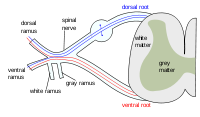
Photo from wikipedia
A 20-year-old female patient was admitted to our department due to ptosis, double vision, and difficulty walking. The symptoms had evolved during the course of 2 months. She had never… Click to show full abstract
A 20-year-old female patient was admitted to our department due to ptosis, double vision, and difficulty walking. The symptoms had evolved during the course of 2 months. She had never been very athletic and was described as always having been a “slow runner,” but otherwise her previous history was unremarkable. There was no family history of neurologic disease. There were no preceding triggering factors such as infections, fever, or physical stress, and the patient did not take valproate. On examination, she had bilateral external ophthalmoplegia and ptosis, grade 4 proximal and distal paresis in the lower extremities, grade 4 distal paresis in the upper extremities, distal sensory loss (for all sensory modalities), and sensory ataxia. After several months, she started experiencing a very slow improvement, which is—at the present moment—still incomplete.
Journal Title: Neurology: Genetics
Year Published: 2019
Link to full text (if available)
Share on Social Media: Sign Up to like & get
recommendations!